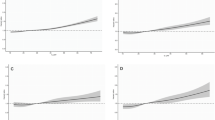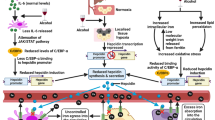Abstract
Objective
Previous studies have found associations between one-carbon metabolism factors and risk of several cancers, but little is known regarding renal cell carcinoma (RCC). We conducted a nested case–control study within the Alpha-Tocopherol, Beta-Carotene Cancer Prevention Study, a prospective study of Finnish male smokers aged 50–69 at baseline.
Methods
Prediagnostic folate, vitamin B6, vitamin B12, cysteine, riboflavin, and homocysteine concentrations were measured in fasting serum from 224 incident RCC cases and 224 controls (matched on age and date of serum collection). Conditional logistic regression was used to calculate odds ratios (ORs) and 95% confidence intervals (CIs), adjusted for potential confounders.
Results
Serum folate tended to be inversely associated with RCC, compared to the first quartile, the odds ratios (95% CI) for subsequent quartiles were 0.62 (0.35–1.08), 0.52 (0.29–0.93), and 0.67 (0.37–1.20) (P-trend = 0.19). When modeled as a threshold effect, subjects in the lowest serum folate quartile (≤6.64 nmol/l), which corresponds to deficient folate status, had a significant increased RCC risk (OR = 1.68, 95% CI 1.06–2.65) compared to those with higher serum folate. The other one-carbon metabolism biomarkers were not associated with RCC.
Conclusions
This study in male smokers suggests that deficient folate status may increase risk of RCC, but confirmation is needed in other epidemiologic studies that include women and non-smokers.
Similar content being viewed by others
References
Chow WH, Devesa SS, Warren JL, Fraumeni JF Jr (1999) Rising incidence of renal cell cancer in the United States. JAMA 281:1628–1631
Ries LAG, Melbert D, Krapcho M, Mariotto A, Miller BA, Feuer EJ, Clegg L, Eisner MP, Horner MJ, Howlader N, Hayat M, Hankey BF, Edwards BK (eds) (http://seer.cancer.gov/csr/1975_2004/ based on November 2006 SEER data submission, posted to the SEER web site 2007) SEER Cancer Statistics Review, 1975-2004. Bethesda, MD: National Cancer Institute
Lipworth L, Tarone RE, McLaughlin JK (2006) The epidemiology of renal cell carcinoma. J Urol 176:2353–2358
McLaughlin JK, Lindblad P, Mellemgaard A et al (1995) International renal-cell cancer study I. Tobacco use. Int J Cancer 60:194–198
McLaughlin JK, Lipworth L (2000) Epidemiologic aspects of renal cell cancer. Semin Oncol 27:115–123
Moore LE, Wilson RT, Campleman SL (2005) Lifestyle factors, exposures, genetic susceptibility, and renal cell cancer risk: a review. Cancer Invest 23:240–255
Lee JE, Giovannucci E, Smith-Warner SA, Spiegelman D, Willett WC, Curhan GC (2006) Intakes of fruits, vegetables, vitamins A, C, and E, and carotenoids and risk of renal cell cancer. Cancer Epidemiol Biomarkers Prev 15:2445–2452
Rashidkhani B, Lindblad P, Wolk A (2005) Fruits, vegetables and risk of renal cell carcinoma: a prospective study of Swedish women. Int J Cancer 113:451–455
van Dijk BA, Schouten LJ, Kiemeney LA, Goldbohm RA, van den Brandt PA (2005) Vegetable and fruit consumption and risk of renal cell carcinoma: results from the Netherlands Cohort Study. Int J Cancer 117:648–654
Weikert S, Boeing H, Pischon T, Olsen A, Tjonneland A et al (2006) Fruits and vegetables and renal cell carcinoma: findings from the European Prospective Investigation into Cancer and Nutrition (EPIC). Int J Cancer 118:3133–3139
Bertoia M, Albanes D, Mayne ST, Mannisto S, Virtamo J, Wright ME (2009) No association between fruit, vegetables, antioxidant nutrients and risk of renal cell carcinoma. Int J Cancer
Lee JE, Mannisto S, Spiegelman D et al (2009) Intakes of fruit, vegetables, and carotenoids and renal cell cancer risk: a pooled analysis of 13 prospective studies. Cancer Epidemiol Biomarkers Prev 18:1730–1739
Stover PJ (2004) Physiology of folate and vitamin B12 in health and disease. Nutr Rev 62:12 (discussion S13)
Friso S, Choi SW (2005) Gene-nutrient interactions in one-carbon metabolism. Curr Drug Metab 6:37–46
Bailey LB, Gregory JF III (1999) Folate metabolism and requirements. J Nutr 129:779–782
Clarke S, Banfield K (2001) S-adenosylmethionine-dependent methyltransferases. In: Carmel R, Jacobson DW (eds) Homocysteine in health and disease. Cambridge Press, Cambridge
Franco R, Schoneveld OJ, Pappa A, Panayiotidis MI (2007) The central role of glutathione in the pathophysiology of human diseases. Arch Physiol Biochem 113:234–258
Choi SW, Mason JB (2000) Folate and carcinogenesis: an integrated scheme. J Nutr 130:129–132
Kim Y-I (1999) Folate and carcinogenesis: evidence, mechanisms, and implications. J Nutr Biochem 10:66–88
Kim Y-I (2007) Folate and colorectal cancer: an evidence-based critical review. Mol Nutr Food Res 51:267–292
Larsson SC, Giovannucci E, Wolk A (2006) Folate intake, MTHFR polymorphisms, and risk of esophageal, gastric, and pancreatic cancer: a meta-analysis. Gastroenterology 131:1271–1283
World Cancer Research/Fund/American Institute for Cancer Research (2007) Food, Nutrition, Physical Activity and the Prevention of Cancer: A Global Perspective. AICR, Washington, DC
Stolzenberg-Solomon RZ, Albanes D, Nieto FJ et al (1999) Pancreatic cancer risk and nutrition-related methyl-group availability indicators in male smokers. J Natl Cancer Inst 91:535–541
Moore LE, Hung R, Karami S, Boffetta P, Berndt S, Hsu CC (2008) Folate metabolism genes, vegetable intake and renal cancer risk in central Europe. Int J Cancer 122:1710–1715
The Alpha-Tocopherol Beta-Carotene Cancer Prevention Study Group (1994) The alpha-tocopherol, beta-carotene lung cancer prevention study: design, methods, participant characteristics, and compliance. Ann Epidemiol 4:1–10
Korhonen P, Malila N, Pukkala E, Teppo L, Albanes D, Virtamo J (2002) The Finnish cancer registry as follow-up source of a large trial cohort—accuracy and delay. Acta Oncol 41:381–388
Shin-Buehring Y, Rasshofer R, Endres WA (1981) A new enzymatic method for pyridoxal-5′ phosphate determination. J Inherit Metab Disorders 4:123–124
Araki A, Sako Y (1987) Determination of free and total homocysteine in human plasma by high-performance liquid chromatography with fluorescence detection. J Chromatogr 422:43–52
Zempleni J, Link G, Kübler W (1992) The transport of thiamine, riboflavin and pyridoxal 5′-phosphate by human placenta. Int J Vitam Nutr Res 62:165–172
Fears TR, Ziegler RG, Donaldson JL et al (2002) Reproducibility studies and interlaboratory concordance for androgen assays of male plasma hormone levels. Cancer Epidemiol Biomarkers Prev 11:785–789
Pietinen P, Hartman AM, Haapa E et al (1988) Reproducibility and validity of dietary assessment instruments: I. A self-administered food use questionnaire with a portion size picture booklet. Am. J. Epidemiol. 128:655–666
Willett W, Stampfer MJ (1986) Total energy intake: implications for epidemiologic analyses. Am J Epidemiol 124:17–27
Mason JB (2003) Biomarkers of nutrient exposure and status in one-carbon (methyl) metabolism. J Nutr 133:941S–947S
Kim Y-I (2008) Folic acid supplementation and cancer risk: point. Cancer Epidemiol Biomarkers Prev 17:2220–2225
Ulrich CM (2008) Folate and cancer prevention—where to next? Counterpoint. Cancer Epidemiol Biomarkers Prev 17:2226–2230
Alfthan G, Laurinen MS, Valsta LM, Pastinen T, Aro A (2003) Folate intake, plasma folate and homocysteine status in a random Finnish population. Eur J Clin Nutr 57:81–88
Brevik A, Vollset SE, Tell GS et al (2005) Plasma concentration of folate as a biomarker for the intake of fruit and vegetables: The Hordaland Homocysteine Study. Am J Clin Nutr 81:434–439
Dietrich M, Brown CJ, Block G (2005) The effect of folate fortification of cereal-grain products on blood folate status, dietary folate intake, and dietary folate sources among adult non-supplement users in the United States. J Am Coll Nutr 24:266–274
Frosst P, Blom HJ, Milos R et al (1995) A candidate genetic risk factor for vascular disease: a common mutation in methylenetetrahydrofolate reductase. Nat Genet 10:111–113
Herbert V (1998) Folic acid. In: Shils M, Olson J, Shike M, Ross AC (eds) Modern nutrition in health and disease, 9th edn. Williams, Wilkins, Baltimore, pp 443–446
Selhub J, Jacques PF, Wilson PW, Rush D, Rosenberg IH (1993) Vitamin status and intake as primary determinants of homocysteinemia in an elderly population. JAMA 270:2693–2698
Mannino DM, Mulinare J, Ford ES, Schwartz J (2003) Tobacco smoke exposure and decreased serum and red blood cell folate levels: data from the Third National Health and Nutrition Examination Survey. Nicotine Tob Res 5:357–362
Gabriel HE, Crott JW, Ghandour H et al (2006) Chronic cigarette smoking is associated with diminished folate status, altered folate form distribution, and increased genetic damage in the buccal mucosa of healthy adults. Am J Clin Nutr 83:835–841
Piyathilake CJ, Macaluso M, Hine RJ, Richards EW, Krumdieck CL (1994) Local and systemic effects of cigarette smoking on folate and vitamin B-12. Am J Clin Nutr 60:559–566
Pfeiffer CM, Johnson CL, Jain RB et al (2007) Trends in blood folate and vitamin B-12 concentrations in the United States, 1988 2004. Am J Clin Nutr 86:718–727
Acknowledgments
This research was supported in part by the Intramural Research Program of the NIH and the National Cancer Institute and by grant TU2-CA-105666. Additionally, this research was supported by Public Health Service contracts N01-CN-45165, N01-RC-45035, and N01-RC-37004 from the National Cancer Institute, Department of Health and Human Services.
Author information
Authors and Affiliations
Corresponding author
Rights and permissions
About this article
Cite this article
Gibson, T.M., Weinstein, S.J., Mayne, S.T. et al. A prospective study of one-carbon metabolism biomarkers and risk of renal cell carcinoma. Cancer Causes Control 21, 1061–1069 (2010). https://doi.org/10.1007/s10552-010-9534-5
Received:
Accepted:
Published:
Issue Date:
DOI: https://doi.org/10.1007/s10552-010-9534-5




